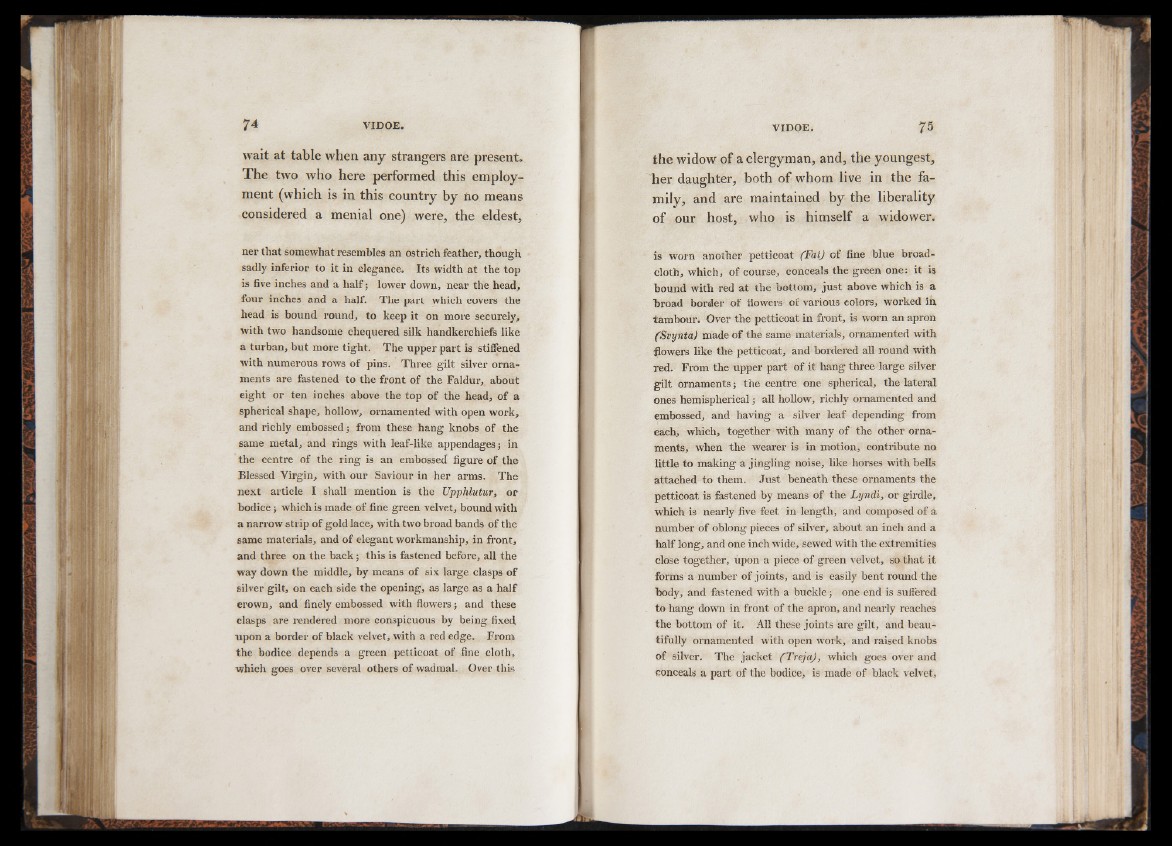
wait at table when any strangers are present.
The two who here performed this employment
(which is in this country by fto means
considered a menial one) were, the eldest,
ner that somewhat resembles an ostrich feather, though
sadly inferior to it in elegance. Its width at the top
is five inches and a half; lower down, near the head,
four inches and a half. The part which covers the
head is bound round, to keep it on more securely,
with two handsome chequered silk handkerchiefs like
a turban, but more tight. The upper part is stiffened
with numerous rows of pins. Three gilt silver ornaments
are fastened to the front of the Faldur, about
eight or ten inches above the top of the head, of a
spherical shape, hollow, ornamented with open work,
and richly embossed; from these hang knobs of the
same metal, and rings with leaf-like appendages; in
the centre of the ring is an embossed figure of the
Blessed Virgin, with our Saviour in her arms. The
next article I shall mention is the Upphlutur, or
bodice; which is made of fine green velvet, bound with
a narrow strip of gold lace, with two broad bands of the
same materials, and of elegant workmanship, in front,
and three on the back; this is fastened before, all the
way down the middle, by means of six large clasps of
silver gilt, on each side the opening, as large as a half
erown, and finely embossed with flowers; and these
clasps are rendered more conspicuous by being fixed
upon a border of black velvet, with a red edge. From
the bodice depends a green petticoat of fine cloth,
which goes over several others of wadmal. Over this
the widow of a clergyman, and, the youngest,
lier daughter, both of whom live in the family,
and are maintained by the liberality
of our host, who is himself a widower.
is worn another petticoat (Fat) of fine blue broadcloth,
which, of course, conceals the green one: it is
bound with red at the bottom, just above which is a
broad border of flowers of various colors, worked in
tambour. Over the petticoat in front, is worn an apron
(Svynta) made o f the same materials, ornamented with
flowers like the petticoat, and bordered all round with
red. From the upper part of it hang three large silver
gilt ornaments; the centre one spherical, the lateral
ones hemispherical; all hollow, richly ornamented and
embossed, and having a silver leaf depending from
each, which, together with many of the other ornaments,
when the wearer is in motion, contribute no
little to making a jingling noise, like horses with bells
attached to them. Just beneath these ornaments the
petticoat is fastened by means of the Lyndi, or girdle,
which is nearly five feet in length, and composed of a
number of oblong pieces of silver, about an inch and a
half long, and one inch wide, sewed with the extremities
close together, upon a piece of green velvet, so that it
forms a number of joints, and is easily bent round the
body, and fastened with a buckle; one end is suffered
to hang down in front of the apron, and nearly reaches
the bottom of it. All these joints are gilt, and beautifully
ornamented with open work, and raised knobs
of silver. The jacket (Treja), which goes over and
conceals a part of the bodice, is made of black velvet,